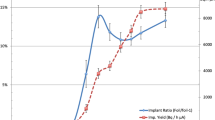Abstract
Measurements of the γ-ray anisotropy of recoil-implanted52Mn ions in pure Au down to 3 mK indicate marked deviations from free-ion behavior in low applied fields. The effective hyperfine field that explains the anisotropy is found to decrease below 10 mK. Although this behavior could be a signature of a “bound” Kondon state with a lower effective hyperfine coupling constant, it is better explained as arising from a combination of Kondo and relaxation effects. The data indicate that the Mn local moment relaxation timeT 1 is comparable to or larger than the Larmor precession time of the Mn nuclei at 3 mK. Other possible reasons for an attenuated γ-ray anisotropy, such as nuclear quadrupole and second-order crystal field effects, are also considered.
Similar content being viewed by others
References
E. C. Hirschkoff, O. G. Symko, and J. C. Wheatley,J. Low Temp. Phys. 5, 155 (1971).
J. C. Doran and O. G. Symko,Solid State Commun. 14, 719 (1974).
J. C. Doran and O. G. Symko, inProc. 19th Conf. on Magnetism and Magnetic Materials (Boston, 1973), p. 980.
J. P. Compton, I. R. Williams, and G. V. H. Wilson, inHyperfine Structure and Nuclear Radiations, E. Matthias and D. A. Shirley, eds. (1968), p. 793.
E. Lagendijk, L. Niesen, and W. J. Huiskamp,Phys. Lett. 30A, 326 (1969).
S. R. de Groot, H. A. Tolhoek, and W. J. Huiskamp inα-β-γ-Ray Spectroscopy, K. Siegbahn, ed. (North-Holland, Amsterdam, 1965), Vol. 2, p. 1199.
T. Yamazaki,Nuclear Data A 3, 1 (1967).
A. Narath,Physica Scripta 11, 237 (1975).
L. G. Mann, D. C. Camp, J. A. Miskel, and R. J. Nagle,Phys. Rev. 137, B1 (1965); Errata,Phys. Rev. 139, AB2 (1965).
K. S. Krane,Nuclear Instr. Meth. 98, 205 (1972).
P. H. Schmidt,J. El. Chem. Soc. 112, 631 (1965).
J. L. Olsen, inElectron Transport in Metals, R. E. Marshak, ed. (Interscience, 1962).
K. Böhning, private communication.
G. Vogl, private communication.
K. Andres, E. Hagn, E. Smolic, and G. Eska,J. Appl. Phys. 46, 2752 (1975).
R. Walstedt and L. R. Walker,Phys. Rev. B 11, 3280 (1975).
I. N. Greifman, V. G. Grachev, and B. K. Krulikovskii,Sov. Phys.—Solid State 17, 1225 (1975).
T. Butz, private communication.
E. Matthias, W. Schneider, and R. M. Steffen,Ark. Fys. 24, 97 (1963).
W. Götze and P. Schlottmann,J. Low Temp. Phys. 16, 87 (1974).
Author information
Authors and Affiliations
Additional information
This work was supported by the Bundesministerium für Forschung und Technologie.
Rights and permissions
About this article
Cite this article
Eska, G., Andres, K., Zech, E. et al. Nuclear orientation of recoil-implanted52Mn in Au down to 3 mK. J Low Temp Phys 28, 551–570 (1977). https://doi.org/10.1007/BF00661449
Received:
Issue Date:
DOI: https://doi.org/10.1007/BF00661449




